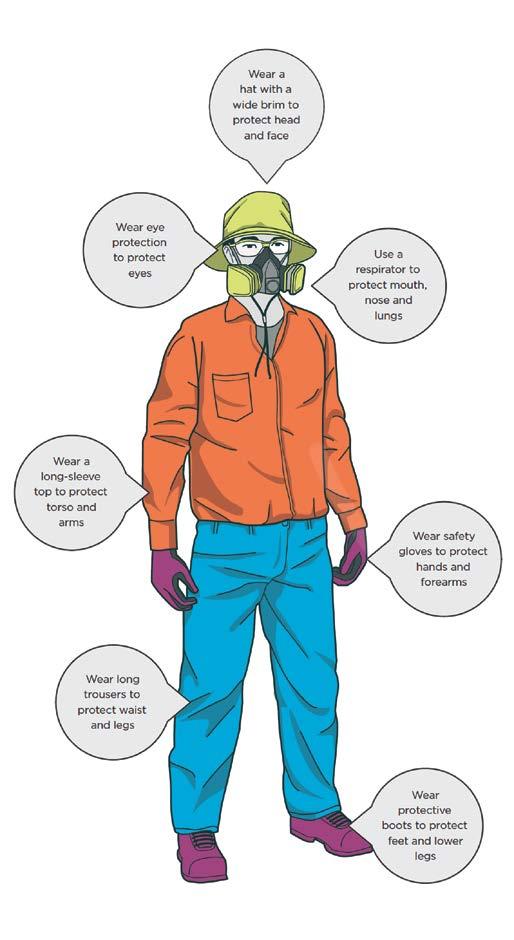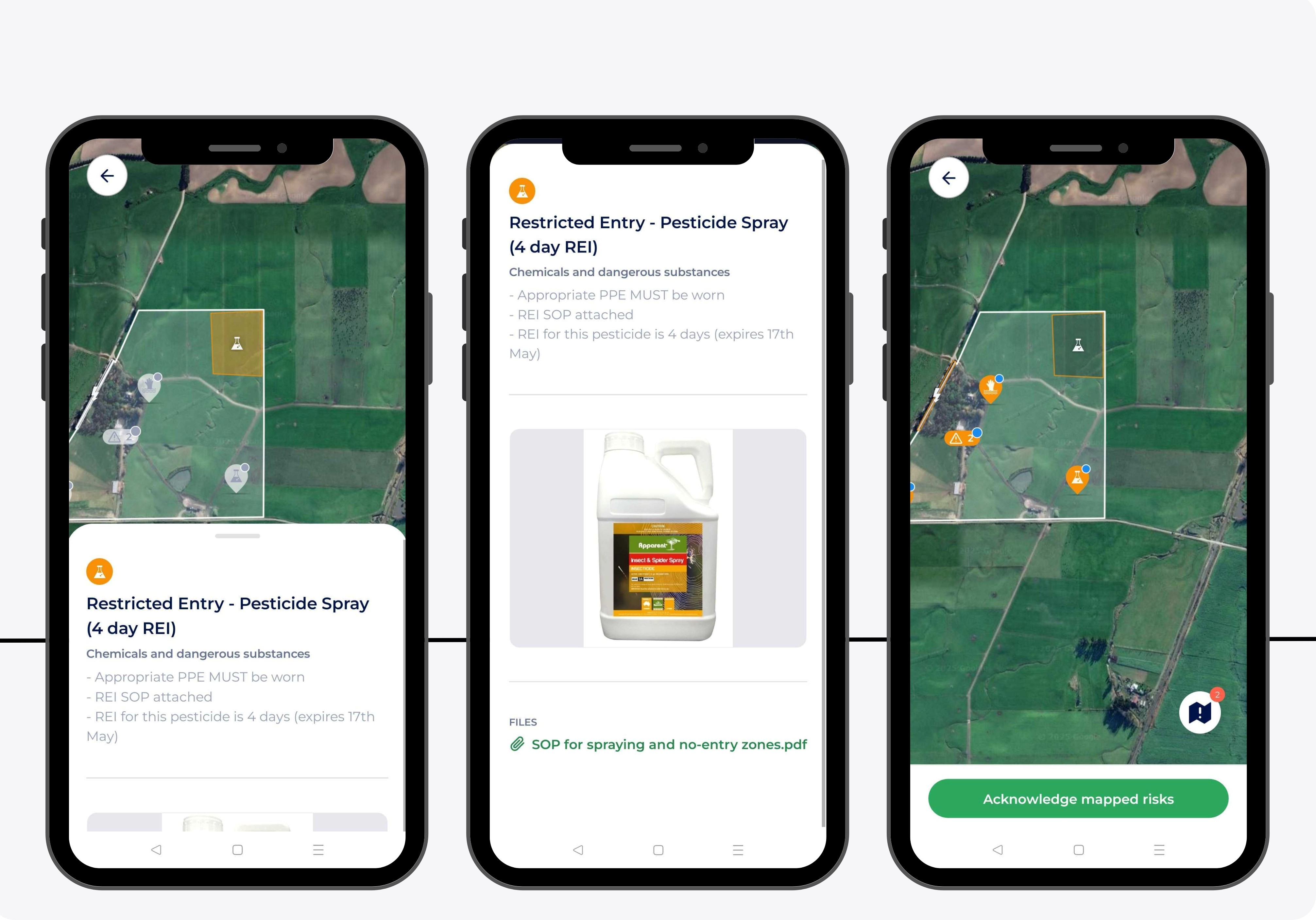
6 minute read
GROWER CONCERNS ABOUT REIs FOR PESTICIDES
WorkSafe NZ has set restricted entry intervals (REIs) for over 100 pesticides. The majority come into force on 10 June 2025. For this overview of the changes, NZGrower & Orchardist spoke to several grower organisations, grower extension technical experts and WorkSafe.
What is an REI?
A restricted entry interval (REI) is a period of time when people are not allowed in an area where a pesticide has been applied unless they are wearing appropriate personal protective equipment (PPE).
The main obligations for growers responsible for the application are that anybody who enters the application area wears appropriate PPE until the end of the REI. For indoor applications, such as a greenhouse, growers must display signs.
WorkSafe has not specified REIs for all pesticides. Growers can check the product label and safety data sheet or visit the WorkSafe website to find more than 100 substances listed.
REIs are different for different crops, even with the same substance. For example, the REI for pesticide carbaryl is 21 days when used on apples and 12 days when used on strawberries.
Why change now?
REIs were previously set as part of the Environmental Protection Authority substance approval process under the Hazardous Substances and New Organisms Act (the HSNO Act). However, WorkSafe was tasked with transferring the REIs to be the requirements under the Health and Safety at Work Act.
WorkSafe set up a working group including representatives from industry associations (including HortNZ), an agriculture training organisation, manufacturers and grower groups, who were able to bring a grower perspective.
In 2022, WorkSafe consulted on a proposal to set a number of REIs. Many of the REIs are new or differ from those previously set under the HSNO Act approval.
Intervals for off-label use
REIs can only be set for crops specified on the label. For off-label use, growers need to carry out their own risk assessment considering the application and type of crop. WorkSafe says they would expect growers to compare the specified REIs for applications of the same substance on similar crops and pick the longest REI.
A grower’s own off-label risk assessment does not require approval from WorkSafe, but WorkSafe inspectors may ask to see documentation showing how the grower assessed the risk.
Particularly for vegetables, where off-label use is very common, this self-assessment requirement is a grey area. Overly conservative estimates may not reflect the actual risk and thereby could disadvantage growers for off-label crops.
Pragmatism required
Feedback during consultation identified that guidance was needed to set out in practical terms what an REI means and what is required to manage the risk during the REI period.
Different re-entry activities in the same application area may require different PPE. The appropriate PPE depends on each situation and will be up to the grower to decide. WorkSafe has produced guidelines to help growers understand the new requirements and determine the appropriate PPE (see QR code overleaf).
However, the new rules may leave growers facing an uncertain liability in their decision making on matters often outside their area of expertise. For example, a covered crop grower would need to determine appropriate PPE that balances the risk of toxicity with working in high temperatures that can reach 40°C for extended periods.
For some of the substances and crops that are not specified in WorkSafe’s new set of REIs, some growers have already been setting their own interval periods in their spray programmes based on overseas labels. This pragmatic approach demonstrates that many growers do see the need for REIs and share concerns about the safety of their workforce – which often includes themselves and their families.
Concerns raised and WorkSafe’s responses
Following WorkSafe’s consultation, HortNZ acknowledged the agency’s genuine engagement with industry and transparency in how WorkSafe arrived at their standards. However, growers raised some concerns after decisions were made on REIs.
Some growers questioned the necessity of REIs for applications that leave no residue on foliage, since REIs are calculated based on spraying the foliage with the pesticide.
WorkSafe is currently consulting on possible changes to the requirements for pesticide applications where there is no residue on foliage, for example pre-emergent sprays or pesticides applied through a drip or sub-surface irrigation system. The updated guidance is underway at the time of writing and, once finalised, will be published on WorkSafe’s website.
Some growers wondered why REIs are longer than preharvest withholding periods. WorkSafe’s response is that toxicity is related to the amount of exposure. The potential exposure from contact with foliage that has pesticide residues on it when working in an application area for a full day is significantly higher than from eating, for example, a few apples a day.
Another concern for growers is how to communicate REI periods. Particularly for growers with large workforces including contractors and multiple crops over multiple leased blocks, it will be a challenge to manage compliance with quickly changing protocols for each site.
There was a high level of concern from industry about the data used to calculate the new REIs. Some growers felt that the process was reinventing the wheel and coming up with REIs that don’t align with those mandated in comparable international jurisdictions.
Growers also spoke about being on the receiving end of rules from multiple government agencies that can seem incoherent. Growers pointed out that some REIs are for substances that are obsolete in other countries, but still relied on by growers in New Zealand because better products overseas are not available in New Zealand. A new REI may effectively eliminate a certain tool for growers, without providing a better alternative.
While the government’s recent Agricultural and Horticultural Products Regulatory Review set recommendations to address some of the causes of the slow approval path (including increasing the reliance and use of assessments by international regulators), the current introduction of new REIs for pesticides offers no relief to the mounting compliance headache that growers face.
The hope expressed by many growers is that the government will take another look at REIs. As one grower put it: despite government promises of reform, this is another case when growers just have to scratch their heads and get on with it.
For further details, visit the WorkSafe website: www.worksafe.govt.nz
Managing Restricted Entry With Software
Growers can use digital solutions to manage site access approvals and streamline compliance. For example, with the Onside platform, when your workforce – employees and contractors – as well as visitors check-in with the app, they will receive instructions for temporary restricted access and PPE requirements.
Guy Davidson, Head of Customer at Onside, says the Onside platform can include an automatic expiry date and time that aligns with the REI. “When a user sets up information on the risk, it can also be set to be automatically removed after the required period, such as in 4 days’ time,” he says. “The app also creates a clear digital record of risk communication that can be used for future reporting and compliance.”











